18 Mar 2019 - {{hitsCtrl.values.hits}}
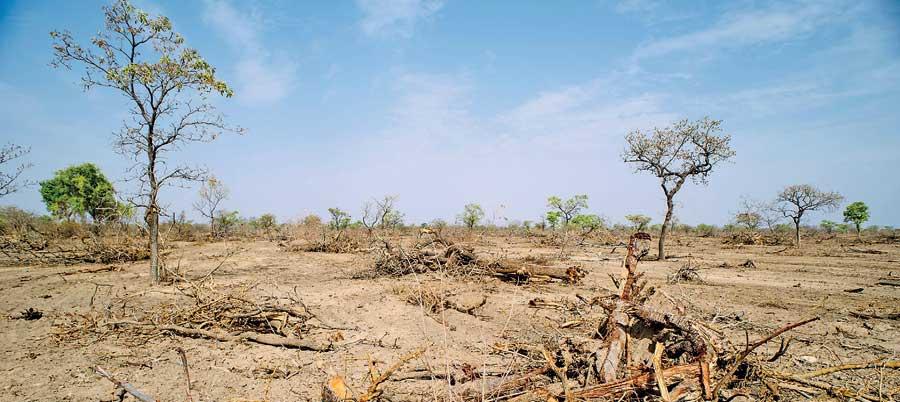
1.6 bn people worldwide depend on forests for livelihood, 300 mn live in them
Besides the loss of habitat, destruction degrades the quality of forestry
A fundamental problem is the belief that humans are the centre of existence
Climate change is no longer an issue any human being can be oblivious to. It is real, it is distressing and it is happening.
In the attempts made to decelerate its pace, and support the planet, trees have become a major point of focus. 
The value of forests cannot be undermined. Being the lungs of the Earth, home to countless species of flora and fauna and an engine that sustains human life, it is a resource we destroy but depend on.
The plummeting quantity and quality of forestry, measures of conservation and sustainable solutions are the critical conversations we should be holding to inspire counteractive measures
moving forward.
With the aim of sparking such dialogue and interest regarding environmental issues that especially affect us locally, the Environmental Foundation (Guarantee) Limited, (EFL) initiated Green Conversations as a platform for enthusiastic and established environmentalists and the general public to connect and exchange ideas.
"Signs are that one doesn’t see the structure of a normal forest in degraded forest. You don’t see the endemic plants that ought to be there. You see lots of invasive plants that aren’t meant to be there and there are big patches inside these degraded forests"
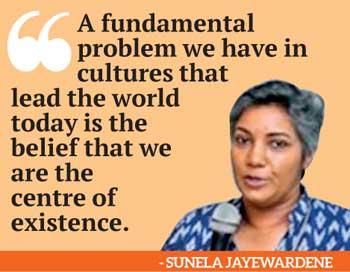 The second event of this series which was held last month explored the topic of deforestation.
The second event of this series which was held last month explored the topic of deforestation.
According to Dr Nirmalie Pallewatte, an Entomologist and Senior Lecturer at the University of Colombo, besides the loss of habitat, the reduction in size and fragmentation of forestry, there exists the equally pressing issue of degradation which affects the quality of forestry.
“You don’t see the structure of a normal forest in degraded forest. You don’t see the endemic plants that ought to be there. You see lots of invasive plants that aren’t meant to be there and there are big patches inside these degraded forests,” these were signs of degradation that Dr Pallewatte listed out.With relation to the UN-REDD programme conducted on the forestry of Sri Lanka, she pointed out that encroachment, infrastructure development and private commercial-scale agricultural ventures are the major drivers of deforestation and degradation.
The United Nations Collaborative Programme on Reducing Emissions from Deforestation and Forest Degradation (REDD) in Developing Countries was launched in 2008.
“I believe that now degradation is becoming more important than the complete loss of forests,” she stated, on account of Sri Lanka’s status as a global biodiversity hotspot.
What is the legal stance on this issue? Are there laws and regulations with respect to forest conservation? If so, are the relevant authorities enforcing these laws?
EFL’s Legal Officer Ms Hafsa Hudha stepped in to explain the dimension of the crisis.
Referring to the EIA; she explained that, “Any development project which is going to convert a particular land exceeding five hectares and in certain instances even limited areas of land, should undergo an Environmental Impact assessment (EIA).”
“There is no doubt that Sri Lanka possesses ample laws to govern the threats to forests; but there exists a demand for reformation, regularisation and consistency of legality,” she said.
Sunela Jayewardene, a renowned Environmental Designer and Architect, shared a fresh perspective on the subject.
“A fundamental problem we have in cultures that lead the world today is the belief that we are the centre of existence.”
Encouraging the building of a harmonious relationship between the natural and the modern world she put forward the concept of sustainable design.
Simplifying the concept, she expressed that this could be all one needs to do- for an environmentally conscious design.
“You need to re-wild and you need to raise groundwater levels,” she said.
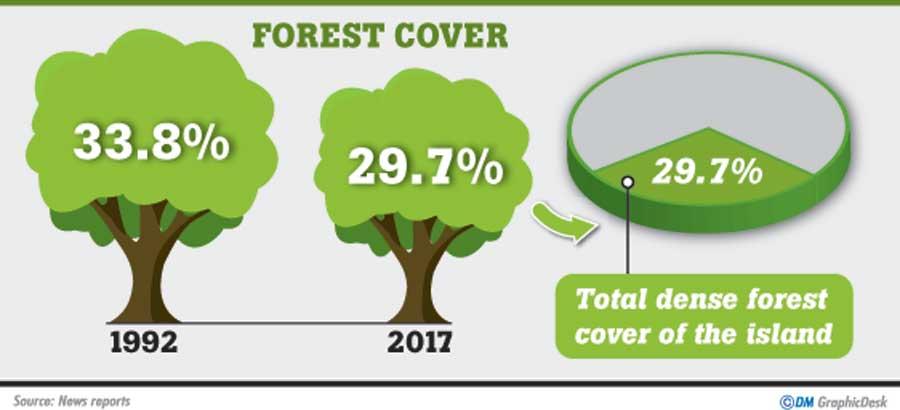
Rewilding, as per Sunela is allowing or encouraging indigenous species to grow. These two objectives, in her opinion, pave the way forward.
The Jetwing Vil Uyana hotel for which she converted an abandoned agricultural land into a wetland rich in biodiversity, Camellia hills in Maskeliya and other private homes which adopted similar innovative go-green strategies were provided examples of sustainable tourism.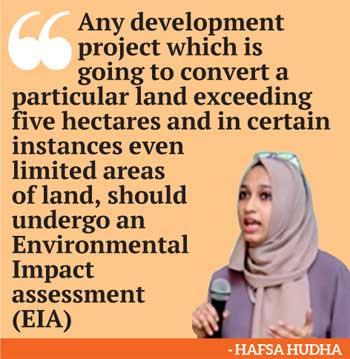
By tapping into the travel industry, sustainable design was recommended not only as a saviour of ecosystems but also as a deliverer of economic benefits.
Keeping up the theme of innovation, Serial Innovator and Entrepreneur, Heminda Jayaweera the Co-Founder of Thuru App described how by applying technology to nature, surprising results might be obtained.
The Thuru App, he explained, encourages reforestation through modern incentives like awarding free data.
The organization continually executes projects to achieve its goals and maintains 10 nurseries island-wide with roughly 10,000 saplings in each.
Moving beyond manual tree planting, Thuru has also developed seed-bearing drones that can expedite the planting of millions of trees in future.
Specially formulated soil that only requires watering once every seven days was among their developments.
In collaboration with the Sri Lanka Institute of Nanotechnology ‘smart seeds’ have also emerged; strengthening non-chemical agriculture locally. “These are seeds you can keep in shelves without planting for at least three months and the moment you place it on the ground, it will start generating.”
Their plans for the future surpass even these levels of novelty.
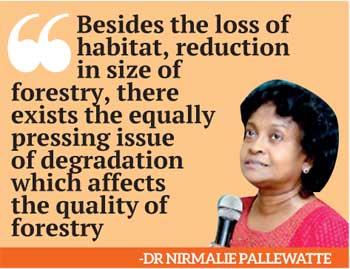 “One of the things we are trying to do is creating a plant that acts like a pet,” Jayaweera said.
“One of the things we are trying to do is creating a plant that acts like a pet,” Jayaweera said.
The last Speaker was Salinda Dissanayake, the Chairperson of a community-based group called Dumbara Surakinno, who has poured his heart and soul into protecting the Knuckles range from illicit human activities such as burning parts of the forests, monitoring irresponsible tourism in the range and improving reforestation.
His experiences revealed how when the masses and the authorities unite, the task of conservation becomes much simpler.
Amidst irregular rainfall in the Knuckles region and its effect on the Mahaweli reservoir water levels, Dissanayake identified forest fires as the biggest threat to the forestry. He added that the dearth of security allows the flocking tourists to enter the preserved forests from anywhere and carry in anything they want to worsen the situation.
“We expect both the Governmental and Non-Governmental support to conserve the World Heritage that is Knuckles,” he stressed.
The event exposed both contrasting and converging aspects of conservation and restoration of our forest resources. Where on one hand eco-tourism was viewed as a smart and profitable strategy, another demanded that restrictions be imposed on tourism which accelerates degradation.
"The plummeting quantity and quality of forestry, measures of conservation and sustainable solutions are the critical conversations we should be holding to inspire counteractive measures moving forward"
It also prompted queries like how far the mechanism involving EIAs is being monitored, the possibility of affordable sustainable eco designs and so on. The discussion’s arousal of such debate and inquiries along with awareness may only be considered as positive steps taken to heighten the conservation of local forestry. The more conversation made, the more the need is realised and action urged.
According to the World Wildlife Fund, 1.6 billion people worldwide depend on forests for their livelihoods, 300 million live in them. It is blatant that the planet is being suffocated by the stifling hands of deforestation, degradation and destruction of forests. And It is clear that immediate and impactful initiatives must be taken to reverse the chaos caused by our own hands to the greenery that sustains our lives.
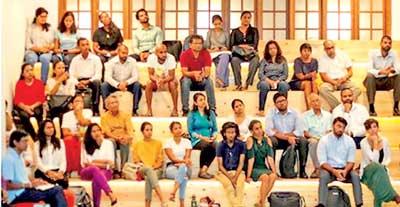
30 Nov 2024 10 minute ago
30 Nov 2024 1 hours ago
29 Nov 2024 29 Nov 2024
29 Nov 2024 29 Nov 2024
29 Nov 2024 29 Nov 2024